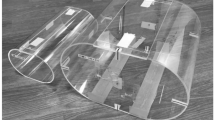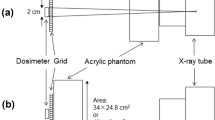Abstract
Background
Pediatric radiography presents unique challenges in balancing image quality and patient dose. Removing the anti-scatter grid reduces patient dose but also reduces image contrast. The benefit of using an anti-scatter grid decreases with decreasing patient size.
Objective
To determine patient thickness thresholds for anti-scatter grid use by comparing scatter-to-primary ratio for progressively thinner patients without a grid to the scatter-to-primary ratio for a standard adult patient with a grid.
Materials and methods
We used Solid Water™ phantoms ranging in thickness from 7 cm to 16 cm to simulate pediatric abdomens. The scatter-to-primary ratio without a grid was measured for each thickness at 60 kVp, 70 kVp and 80 kVp for X-ray fields of view (FOV) of 378 cm2, 690 cm2 and 1,175 cm2 using indirect digital radiography (iDR) and computed radiography (CR). We determined thresholds for anti-scatter grid use by comparing the intersection of a fit of scatter-to-primary ratio versus patient thickness with a standard adult scatter-to-primary ratio measured for a 23-cm phantom thickness at 80 kVp with an anti-scatter grid. Dose area product (DAP) was also calculated.
Results
The scatter-to-primary ratio depended strongly on FOV and weakly on kVp; however DAP increased with decreasing kVp. Threshold thicknesses for grid use varied from 5 cm for a 14 × 17-cm FOV using iDR to 12 cm for an 8 × 10-cm FOV using computed radiography.
Conclusions
Removing the anti-scatter grid for small patients reduces patient dose without a substantial increase in scatter-to-primary ratio when the FOV is restricted appropriately. Radiologic technologists should base anti-scatter grid use on patient thickness and FOV rather than age.





Similar content being viewed by others
References
Carlton RR, Adler AM (2012) The grid. In: Principles of radiographic imaging: an art and a science, 5th edn. Delmar Cengage Learning, Clifton Park, pp 257–272
Alzen G, Benz-Bohm G (2011) Radiation protection in pediatric radiology. Dtsch Arztebl Int 108:407–414
European Commission (1996) European guidelines on quality criteria for diagnostic images in paediatrics. ftp://ftp.cordis.lu/pub/fp5-euratom/docs/eur16260.pdf. Accessed May 1, 2013
American College of Radiology (2008) ACR-SPR practice guidelines for general radiography. http://www.acr.org/~/media/95AB63131AD64CC6BB54BFE008DBA30C.pdf. Accessed May 1, 2013
International Atomic Energy Agency (2013) Safety report series No. 71, radiation protection in paediatric radiology. http://www-pub.iaea.org/books/iaeabooks/8727/Radiation-Protection-in-Paediatric-Radiology. Accessed May 1, 2013
Ween B, Olstad M, Jakobsen JA et al (2009) Pediatric digital chest radiography, comparison of grid versus non-grid techniques. Eur J Radiography 1:201–206
IEC International Standard 60627 (2001) Diagnostic X-ray imaging equipment—characteristics of general purpose and mammographic antiscatter grids. International Electrochemical Commission, ISBN 2-8318-5953-0
Hall EJ (2002) Lessons we have learned from our children: cancer risks from diagnostic radiology. Pediatr Radiol 32:700–706
Amis ES Jr, Butler PF, Applegate KE et al (2007) American College of Radiology white paper on radiation dose in medicine. J Am Coll Radiol 4:272–284
Conway BJ, Duff JE, Fewell TR et al (1990) A patient-equivalent attenuation phantom for estimating patient exposures from automatic exposure controlled X-ray examinations of the abdomen and lumbo-sacral spine. Med Phys 17:448–453
American College of Radiology (2008) ACR Practice Guideline for Diagnostic Reference Levels in Medical X-ray Imaging. http://www.acr.org/~/media/796DE35AA407447DB81CEB5612B4553D.pdf. Accessed May 1, 2013
Yaffe M, Fenster A, Johns HE (1977) Xenon ionization detectors for fan beam computed tomography scanners. J Comput Assist Tomogr 1:419–428
Floyd CE Jr, Lo JY, Chotas HG et al (1991) Quantitative scatter measurement in digital radiography using a photostimulable phosphor imaging system. Med Phys 18:408–413
Fetterly KA, Schueler BA (2007) Experimental evaluation of fiber-interspaced antiscatter grids for large patient imaging with digital x-ray systems. Phys Med Biol 52:4863–4880
American College of Radiology (2012) ACR-AAPM-SIIM practice guideline for digital radiography. http://www.acr.org/~/media/3E08C87AD6E6498D9E19769E5E5E390D.pdf. Accessed May 1, 2013
American College of Radiology (2011) ACR-SPR guideline for the performance of abdominal radiography. http://www.acr.org/~/media/79A594819BBD4631A7E31404DAA66EF6.pdf. Accessed May 1, 2013
Rosenstein M, Beck TJ, Warner GG (1979) Handbook of selected organ doses for projections common in pediatric radiology. HEW Publication FDA pp. 79–8079
Rosenstein M (1988) Handbook of selected tissue doses for projections common in diagnostic radiology. HEW Publication FDA pp. 89–8031
Maher KP (1993) Comparison of scatter measurement techniques in digital fluoroscopy. Phys Med Biol 38:1977–1983
Yaffe MJ, Johns PC (1983) Scattered radiation in diagnostic radiology—magnitudes, effects, and methods of reduction. J Appl Photogr Eng 9:184–195
Kleinman PL, Strauss KJ, Zurakowski D et al (2010) Patient size measured on CT images as a function of age at a tertiary care children’s hospital. AJR Am J Roentgenol 194:1611–1619
Aichinger H, Dierker J, Joite-Barfuß S et al (2012) Scattered radiation. In: Radiation exposure and image quality in X-Ray diagnostic radiology, 2nd edn. Springer, Berlin, pp 53–66
Curry TS III, Dowdey JE, Murry RC Jr (1990) Christensen’s physics of diagnostic radiology, 4th edn. Lippincott, Williams, and Wilkins, Philadelphia
Goske MJ, Charkot E, Herrmann T et al (2011) Image Gently: challenges for radiologic technologists when performing digital radiography in children. Pediatr Radiol 41:611–619
Conflicts of interest
None.
Author information
Authors and Affiliations
Corresponding author
Rights and permissions
About this article
Cite this article
Fritz, S., Jones, A.K. Guidelines for anti-scatter grid use in pediatric digital radiography. Pediatr Radiol 44, 313–321 (2014). https://doi.org/10.1007/s00247-013-2824-9
Received:
Revised:
Accepted:
Published:
Issue Date:
DOI: https://doi.org/10.1007/s00247-013-2824-9




